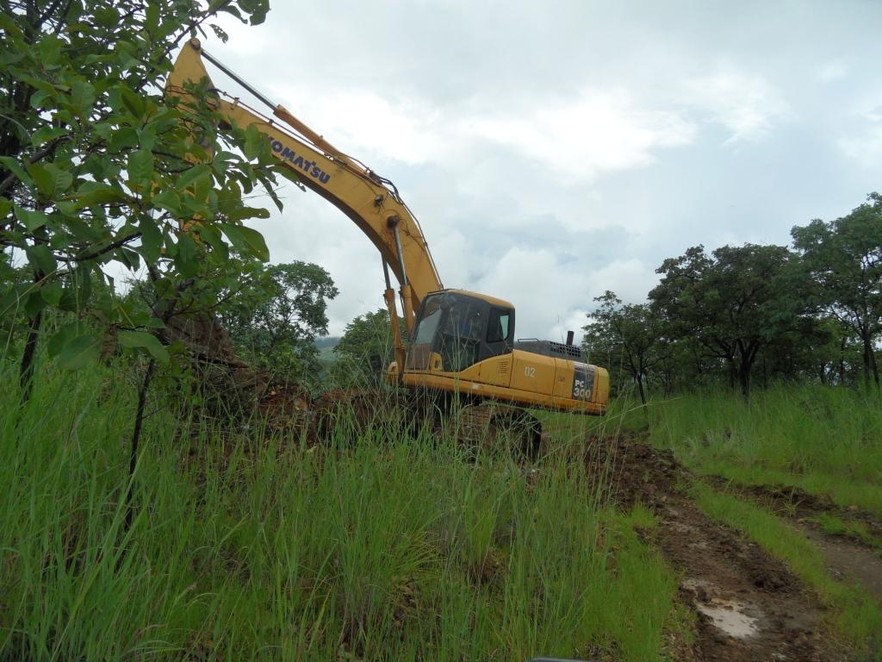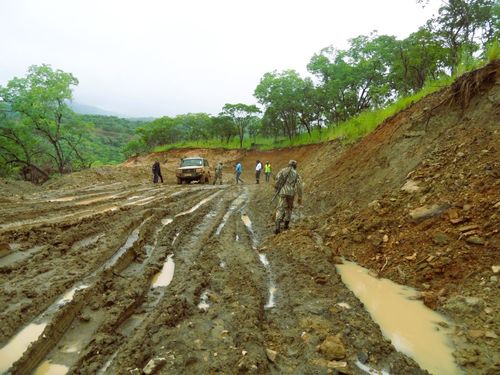By Charles Mafa
Excavation for a vast open cast copper mine in the heart of the Lower Zambezi National Park has begun. The bulldozers’ move into Zambia’s pristine wildlife sanctuary and famous tourist attraction follows a decade-long fight by activists trying to stop the mining.
The move follows an about-turn by Zambia’s government environmental agency and by President Hakainda Hichilema, who had been outspoken about being opposed to the mine. The green light given to the mining company to start clearing work has raised questions about what political leverage mine owners may have had.
Mwembeshi Resources Limited first applied for mining rights in the park in 2011 and submitted an Environmental Impact Statement (EIS). The Zambia Environmental Management Agency (ZEMA) rejected the EIS. The mining company appealed and in 2014 the Zambian government approved the application for the Kangaluwi copper mine in south-eastern Zambia on the national park land.
Lower Zambezi is a vital part of the wider Zambezi basin, a significant shared resource that contributes to the economic, environmental and social development of southern Africa.
In 2014 the Lower Zambezi Tourism Association (LZTA) warned that the proposed mine would cost the Zambian economy billions of dollars a year in foreign investment and livelihoods. The tourism association said it would also destroy an ecosystem that is home to 124 species of animal, 403 species of birds and 54 aquatic animals. The association’s models also concluded that the mine was not viable.
“Modeling figures suggest that the project is not economically viable, will result in a net loss of jobs for local communities, and will generate a financial loss over the first seven years of operation of a minimum of US$13 million”, the report found.
“Locally, the project would risk a minimum of US$5 million of NGO investment in community development programmes that align with protected area management.
“In broader terms, there is great potential for mining inside protected areas to have a negative effect on international aid investment, upon which Zambia is heavily reliant and receives over $1 billion annually.”
This report coupled with objections and reports by a coalition of activists helped secure a court injunction to stop the mine. However, eight years later, the mine has successfully secured the right to mine.
The company has dismissed these concerns, saying that the mine is a mark of progress and job creation of which communities are in favour.
Mwembeshi Resources would not confirm or deny whether work on the mine has started.
“Your questions are so specific and you seem not to be interest(ed) in more important things about the mine, like value, jobs, benefits or the big support the mine has from the local community,” said Oliver Shalala, communications and corporate affairs manager. He added that the mine enjoys a lot of support among “black Zambians”.
“It is the white lodge owners, who have been known to be involved in illegal mining and poaching in the Lower Zambezi, who are fighting the mine based on untruths, half-truths and indeed wrong assumptions,” he charged.
Shalala is adamant that anyone opposed to the project or writing about it is just wasting their time “because Zambia needs development and not politicking”.
Stephen Malenga, the council secretary for Luangwa district where the mine is located, confirmed to MakanDay that work, including on the roads, has started.
“In April, I sent a team responsible for revenue collection (at the council) to Lower Zambezi to establish facts about the mine after hearing reports that it was operational,” he said.
“What they found was that the roads are being worked on and office blocks were being constructed but they were not completed, an airstrip has also been constructed at the mine.”
A decade-long fight turns into a sinkhole
The proposed mine is an open-pit mine which involves the excavation of a large open hole or a series of pits. These are gradually deepened and expanded to extract the desired mineral – in this case, copper.
Open-pit mining typically involves the use of heavy equipment, such as bulldozers, excavators and trucks to remove overlying material and expose the mineral deposit. Storage facilities are used to store the waste materials generated from mining operations, called tailings. These waste materials, including dangerous chemicals, are stored in dams constructed near mining sites. Any leaks or faults would threaten the entire ecosystem.
In 2011, when the mine first applied for a licence to operate in the area, activists warned about the threat of permanently damaging a significant portion of the park. Although it is not clear how big the mine area will be, the Environmental Impact Assessment explains how the main construction phase activities include road construction, site clearance, earthworks, open pit excavation and construction of the concentrator plant. Other work includes building a tailings storage facility, water storage tanks and fencing.

When the Zambia Environmental Management Agency (ZEMA) rejected the EIS in 2012, the environmental agency’s technical experts flagged degradation of the escarpment habitat, wilderness values and river pollution as key concerns on a long list of potential adverse impacts.
ZEMA stated that the the mine would “destroy the landscape of the park”. It also warned that the proposed tailings storage facilities were “risky” and the “chances of failure are high”.
Two years after ZEMA rejected the mine’s EIS, Zambia’s then minister of lands, Harry Kalaba, approved the project. It was stopped by the court injunction, and Hichilema, who was in the opposition at the time, made his objection to mining in the national park clear on social media, in 2014 and again in 2019.

In 2021, ZEMA changed its mind and approved the mining company’s EIS it had rejected in 2012. The EIS expired in 2021. A coalition of environmental activists, the Conservation Advocates Zambia (CAZ), approached the courts to reverse ZEMA’s approval but Zambia’s Court of Appeal dismissed the case in February 2021. In addition to the Kangaluwi open-pit site, the EIS outlines how operations are likely to be undertaken at three satellite sites – Kalulu, Chisawa and Imboo.
CAZ also asked ZEMA to review its decision and, after getting no response they applied to the High Court asking for a judicial review of ZEMA’s decision to approve the expired EIS which it had initially rejected. This hearing was adjourned twice before grinding to a halt on 30 March this year when ZEMA said it had “no authority” to review its own decision.
On 27 April, CAZ sent a plea to Minister of Green Economy and Environment, Collins Nzovu, to stop all activities related to the mining operation. He has not yet responded.
Aside from unanswered questions about whether there was any political influence exerted to approve the project, the events have also raised questions about President Hichilema’s “new deal” commitment to protect and conserve the country’s treasured forests and national parks.
Mine ownership
The mine is owned by a Zambian registered Mwembeshi Resources Limited. Mwembeshi Resources (Bermuda) is the largest shareholder and the company is owned by a Chinese conglomerate (the majority owned by Hu Kaijun and Chinese government stakeholders). Other companies that hold shares include Metex Resources Limited and Amazon Associates Limited.
There are also Individual shareholders in Mwembeshi Resources, and they include Stephen Mulenga, Willie Rutherlain Sweta, Hyden Hara, Pengani Yangailo, and an Austrian – Marinko Vidovic, according to the Patents and Companies Registration Agency records.
Weak legal framework
While the Mines and Minerals Development Act (2008) and the Zambia Wildlife Act (1998) allow for mining inside national parks, there is no policy or legal framework to guide implementation, monitoring and mitigation of impacts such as ensuring full site rehabilitation as is outlined by the Mines and Mineral Resources Development Act.
Section 80 of this Act prescribes “the rehabilitation, levelling, re-grassing, reforesting or contouring of such part of the land over which the right or licence has effect as may have been damaged or adversely affected by exploration operations, mining operations or mineral processing operations; and(d) the filling in, sealing or fencing of excavations, shafts and tunnels”.

Additional reporting by Linda Soko

Discover more from MAKANDAY
Subscribe to get the latest posts sent to your email.



